1996 PONTIAC GRAND-AM engine
[x] Cancel search: enginePage 167 of 356

Hydroplaning
Hydroplaning is dangerous. So much water can build up
under your tires that they can actually ride on the water.
This can happen if the road is wet enough and you’re
going fast enough. When your vehicle
is hydroplaning,
it has little or no contact with the road.
Hydroplaning doesn’t happen often. But
it can if your
tires haven’t much tread or if the pressure in one or
more
is low. It can happen if a lot of water is standing on
the road. If you can see reflections from trees, telephone
poles or
other vehicles, and raindrops “dimple” the
water’s surface, there could
be hydroplaning.
Hydroplaning usually happens at higher speeds. There
just isn’t a hard and fast rule about hydroplaning. The
best advice is to slow down when it is raining.
Driving Through Deep Standing Water
NOTICE:.
If you drive too quickly through deep puddles or
standing water, water can come in through your
engine’s air intake and badly damage
your
engine. Never drive through water that is slightly
lower than the underbody
of your vehicle. If you
can’t avoid deep puddles or standing water, drive
through them very slowly.
Some Other Rainy Weather Tips
TUm on your low-beam headlamps -- not just your
parking
lamps -- to help make you more visible to ‘’
others.
Besides slowing down, allow some extra following
distance.
And be especially careful when you pass
another vehicle. Allow yourself
more clear room
ahead, and be prepared to have your view restricted
by road spray.
“Tires”
in the Index.)
Have good tires with proper tread depth. (See
4-19
ProCarManuals.com
Page 170 of 356

The exit speed is usually posted.
Reduce your speed according
to your speedometer, not
to your sense of motion. After
driving for any distance
at higher speeds, you may tend to think you are going
slower than you actually are.
Before Leaving on a Long Trip
Make sure you’re ready. Try to be well rested. If you
must
start when you’re not fresh -- such as after a day’s
work
-- don’t plan to make too many miles that first part
of the journey. Weax comfortable clothing and shoes you
can easily drive in.
Is your vehicle ready for a long trip? If you keep it
serviced and maintained, it’s ready to
go. If it needs
service, have it done before
starting out. Of course,
you’ll find experienced and
able service experts in
Pontiac dealerships all across North America. They’ll be
ready and willing to help
if you. need it. Here are some things
you can check before a trip:
WindshieZd Washer Fluid: Is the reservoir
full? Are
all windows clean inside and outside?
Wiper Blades: Are they in good shape?
Fuel, Engine Oil, Other Fluids: Have you checked
Lamps: Are they all working? Are the lenses clean?
‘Tires: They are vitally important to a safe,
all levels?
trouble-free
trip. Is the tread good enough for
long-distance driving? Are the tires all inflated
to the
‘ recommended pressure?
Weather Forecasts: What’s the weather outlook
along your route? Should you delay your trip a short
time to avoid a major
storm system?
Maps: Do you have up-to-date maps?
4-22
ProCarManuals.com
Page 171 of 356
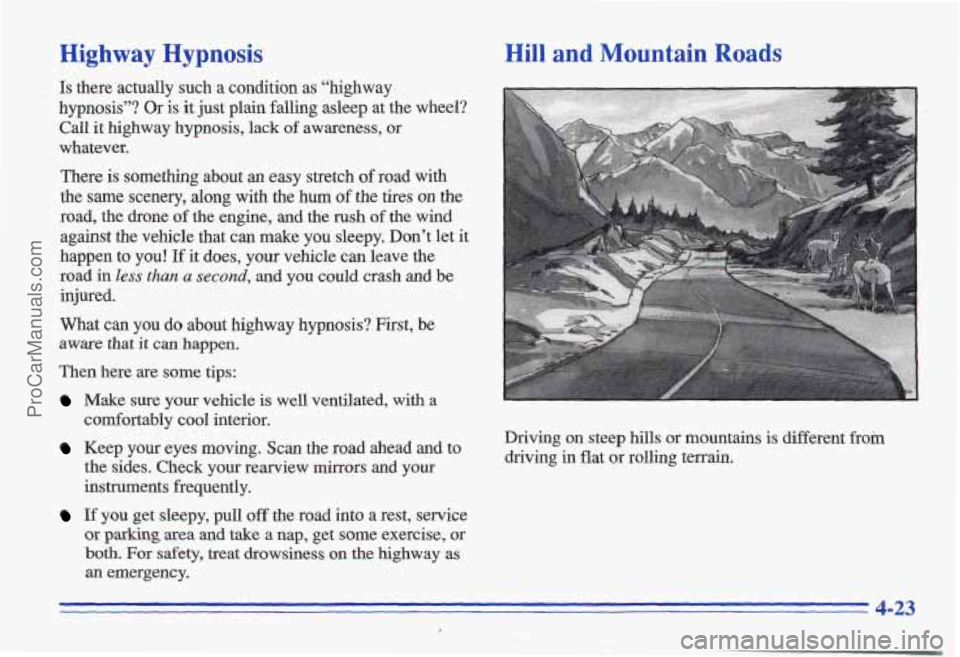
Highway Hypnosis
Is there actually such a condition as “highway
hypnosis”? Or is it just plain falling asleep at the wheel?
Call it highway,hypnosis, lack
of awareness, or
whatever.
There is something about an easy stretch of road with
the
same scenery, along with the hum of the tires on the
road, the drone
of the engine, and the rush of the wind
against the vehicle that can make you sleepy. Don’t let it
happen to you!
If it does, your vehicle can leave the
road
in Zess than a second, and you could crash and be
injured.
What
can you do about highway hypnosis? First, be
aware that it can happen.
Then here are some tips:
Make sure your vehicle is well ventilated, with a
Comfortably cool interior.
Keep your eyes moving. Scan the road ahead and to
the sides. Check your rearview mirrors and your
instruments frequently.
If you get sleepy, pull off the road into a rest, service
or
parking area and take a nap, get some exercise, or
both. For safety, treat drowsiness on the highway as
an emergency.
Hill and Mountain Roads
Driving on steep hills or mountains is different from
driving
in flat or rolling terrain.
4-23
ProCarManuals.com
Page 172 of 356
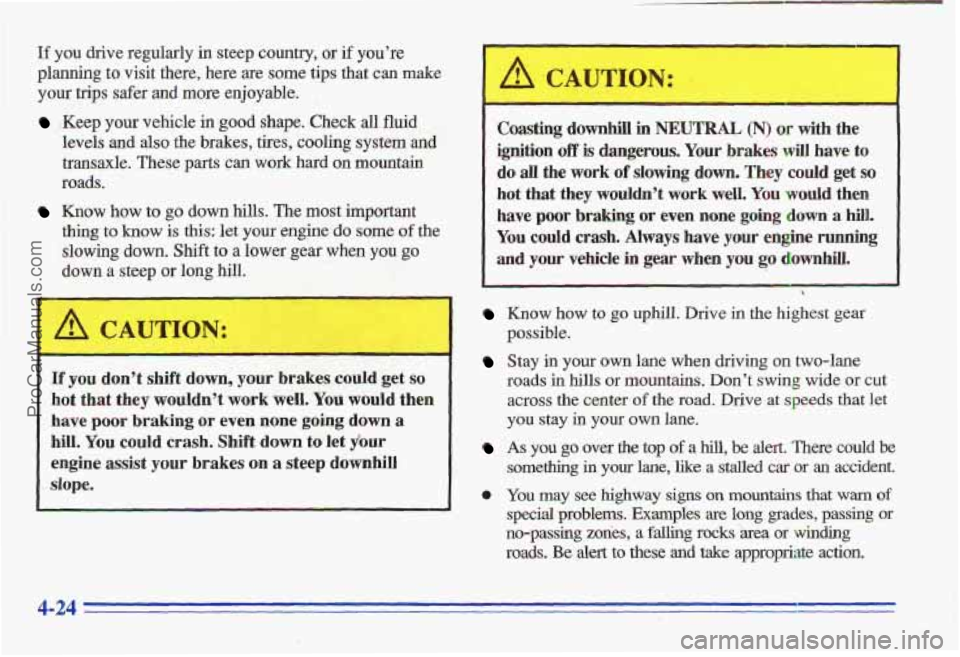
If you drive regularly in steep country, or if you’re
planning t’o visit there, here are some tips that can make
your trips safer and more enjoyable.
!Keep your vehicle in good shape. Check dl fluid
levels
and also the brakes, tires, cooling system and
transaxle.
These parts can work hard on mountain
roads.
Know Bow to go down hills. The most important
thing to know is this: let your engine do some of the
slowing down. Shift to a lower gear when you go
down a steep or long hill.
If you don’t shift down, your brakes could get so
hot that they wouldn’t work well. You would then
have poor braking
or even none going ddwn a
hill. You could crash. Shift down to let jour
engine assist
your brakes on a steep. downhill
.. slope.
Coasting downhill in NEUTRAL (N) or dvith the
ignition
off is dangerous. Your brakes will have to
do all the work of slowing down. They could get so
hot that they wouldn’t work well. You would then
haxe
poor braking or even none going down a hill.
You could crash. Always have your engine running
and your vehicle
in gear when you go downhill.
Know how to go uphill. Drive in the highest gear
possible.
Stay in your own lane when driving on two-lane
roads
in hills or mountains. Don’t swing wide or cut
across the center
of the road. Drive at speeds that let
you stay in your own lane.
As you go over the top of a hill, be alert. There could be
something in your lane, like a stalled car or an accident.
0 You may see highway signs on mountains that warn of
special problems. Examples are long grades, passing or
no-passing
zones, a falling rocks Area or winding
roads. Be alert to these and take appropriate action.
ProCarManuals.com
Page 176 of 356
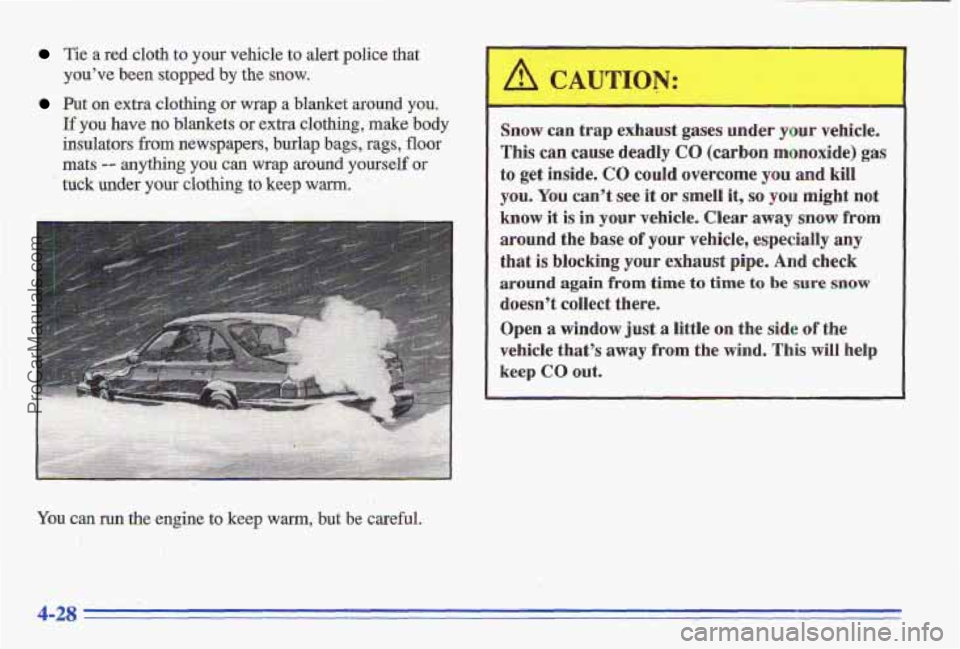
Tie a red cloth to your vehicle to alert police that
you’ve been stopped by the snow.
Put on extra clothing or wrap a blanket around you.
If you have no blankets or extra clothing, make body
insulators
frob newspapers, burlap bags, rags, floor
mats -- anything you can wrap around yourself or
tuck under your clothing to keep warm. ..
Snow can trap exhaust gases under your vehicle.
This
can cause deadly CO (carbon monoxide) gas
to get inside. CO could overcome you and kill
you. You can’t see it or smell it, so you might not
know it is in your vehicle. Clear away snow from
around the base of your vehicle, especially any
that
is blocking your exhaust pipe. And check
around again from time to time to be sure snow
doesn’t collect there.
Open
a window just a little on the side of the
vehicle that’s away from the wind. This will help
keep
CO out.
You can sun the engine to keen warm, but be careful.
1. ..
‘4 . ’% . , ! 1- . ,;
4-28
.. .
ProCarManuals.com
Page 177 of 356
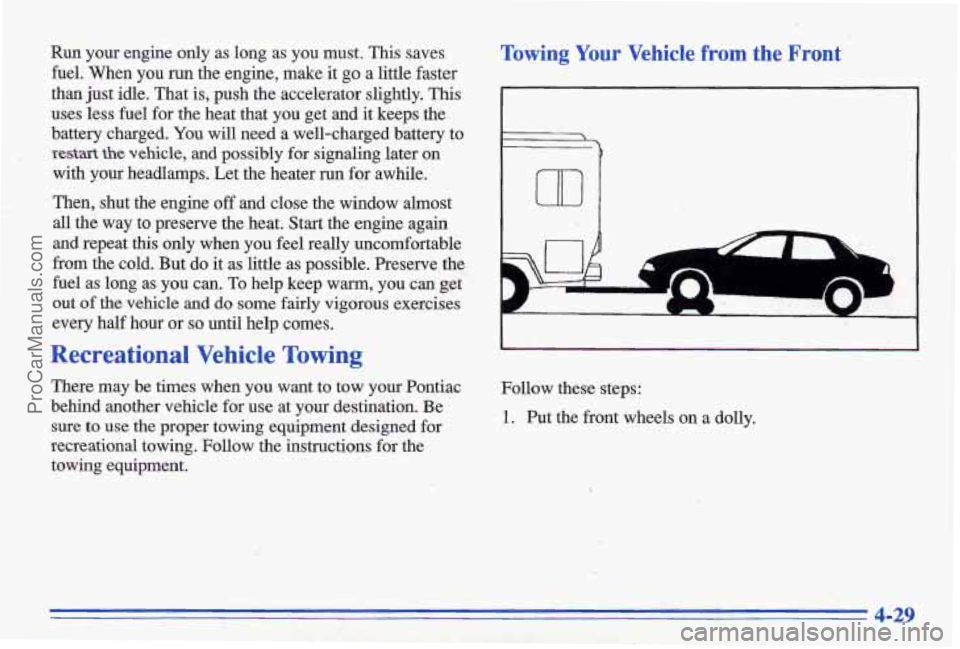
Run your engine only as long as you must. This saves
fuel. When you run the engine, make it go a little faster
than just idle. That is, push the accelerator slightly. This
uses less fuel for the heat that you get and it keeps the
battery charged. You will need a well-charged battery to
rest& the vehicle, and possibly for signaling later on
with your headlamps. Let the heater run for awhile.
Then, shut the engine
off and close the window almost
all the way to preserve the heat. Start the engine again
and repeat this only when you feel really uncomfortable
from the co1d:But do it as little as possible. Preserve the
fuel
as long as you can. To help keep warm, you can get
out of the vehicle and do some fairly vigorous exercises
every half hour or
so until help comes.
Recreational Vehicle Towing
There may be times when you want to tow your Pontiac
behind another vehicle for use at your destination. Be
sure
to use the proper towing equipment designed for
recreational towing. Follow the instructions for the
towing equipment.
Towing Your Vehicle from the Front
Follow these steps:
1. Put the front wheels on a dolly.
i '_ .-
4-29
ProCarManuals.com
Page 182 of 356
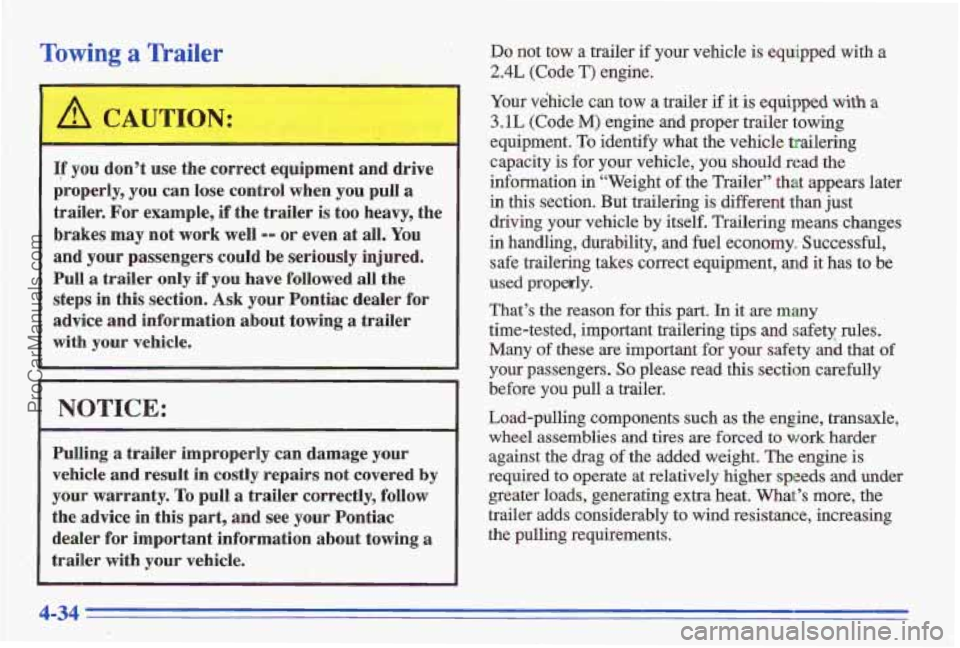
Towing a Trailer
A CAUTION:
If you don't use the correct equipment and drive
properly, you can lose control when
you pull a
trailer. For example, if the trailer is too heavy, the
brakes may not
work well -- or even at all.. You
and your passengers could be seriously injured.
Pull
a trailer only if you have followed all the
steps in this section.
Ask your Pontiac dealer for
advice and information about towing
a trailer
with your vehicle.
Pulling
a traikr improperly can damage your
vehicle and result in costly repairs not covered
by
your warranty. To pull a trailer correctly, follow
the advice in this part, and
see yumr Pontiac
dealer for important information about towing
a
trailer with your vehicle.
Bo not tow a trailer if your vehicle is equipped with a
2.4L (Code T) engine.
Your vehicle can tow a trailer if it is equipped with a
3.1L (Code M) -engine and proper trailer towing
equipment,
To identify what the vehicle trailering
capacity
is for your vehicle, you should read the
information
in "Weight of the Trailer'' that appears later
in this section. But trailering is different than just
driving your vehicle
by itself. Trailering means changes
in handling, durability, md fuel economy. Successful,
safe trailering takes correct equipment, and it has to be
used propetly.
That's the reason for this
part. In it are many
time-tested, important trailering tips and safe% rules.
Many of these are important for your safety and that of
your passengers. So please read this section carefully
before you pull a trailer.
Load-pulling components such as the engine, transaxle,
wheel assemblies and tires are forced to work harder
against
the drag of the added weight. The engine is
required to operate at relatively
higher speeds and under
greater loads, generating extra heat. What,'s more, the
trailer adds considerably to wind resistance, increasing
the gulling requjsernents.
1'
4-34
ProCarManuals.com
Page 183 of 356
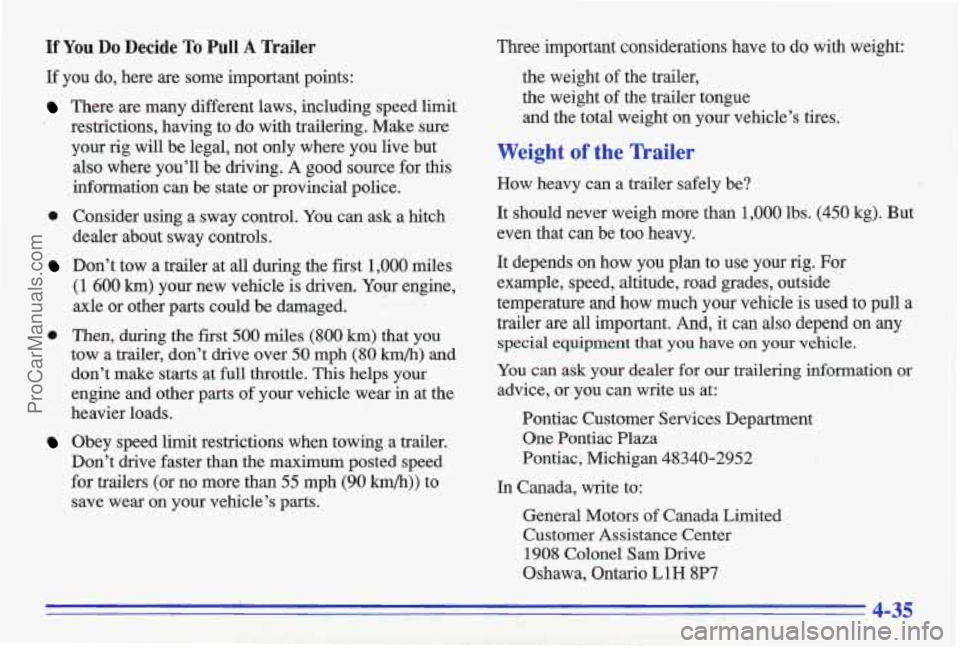
If You Do Decide To Pull A Trailer
If you do, here are some important points:
Three important considerations have to do with weight:
the weight
of the trailer,
There are many different laws, including speed limit
’ restrictions, having to do with trailering. Make sure
your
rig will be legal, not only where you live but Weight of the Trailer
also where you’ll be driving. A good source for this
inforrnation can be state or provincial police. How heavy can a trailer safely be? the weight
of the trailer tongue
and the total weight on your vehicle’s tires.
0 Consider using a sway control. You can ask a hitch It should never weigh more than 1,000 lbs. (450 kg). But
dealer about sway Controls’. even that can be
too heavy.
Don’t tow a trailer at all during the first 1,000 miles It depends on how YOU plan
to use Your fig. For
(1 600 km) your new vehicle is driven. Your engine, exmPle,
speed, altitude, road grades, outside
axle or other parts could
be damaged. temperature and how much your vehicle
is used to pull a
tow a trailer, don’t drive over 50 mph (80 h/h) and
don’t make starts at full throttle. This helps your
You can ask your dealer for our trailering information or
engine and other parts of your vehicle wear in at the advice, Or-You Can write
US at:
heavier loads. Pontiac Customer Services Department
Don’t drive faster than the maximum posted speed Pontiac, Mi\
chigan 48340-2952 trailer are
all important. And,
it can also depend on any 0 Then, during the first 500 miles (800 km) that you
special equipment that you have on your vehicle.
Obey speed limit restrictions when towing a trailer. One Pontia\
c Plaza
for trailers (or no more than 55 mph (90 lun/hj) to
save wear on your vehicle’s parts. In Canada, write to:
General Motors of Canada Limited
Customer Assistance Center
1908 Colonel Sam Drive
Oshawa, Ontario
L1H 8P7
4-35
ProCarManuals.com